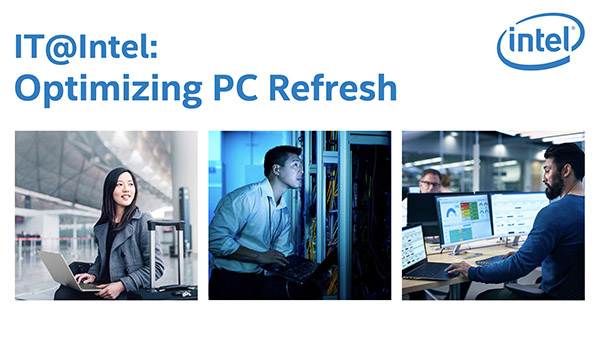Optimizing PC Refresh

IT Best Practices: Optimizing PC refresh is a priority for Intel IT. It is imperative that Intel employees have up-to-date technology and devices that let them perform their jobs efficiently. Intel IT historically updated on-sta? engineers’ devices every three years; other direct hire, full-time employees every four years; and waterfalled older machines to contingent workers. But discussions with employees revealed they needed faster and lighter laptops to help them do their jobs easier, more efficiently, and more comfortably.
We embarked on an initiative to provide Intel’s workforce with new technology every three years—or less—across the board. We are also working on providing employees with a device that supports their particular job. We use telemetry data—while protecting the users’ privacy—to discern work habits and identify individual computing needs. We measure things like CPU and memory utilization, wait time, on/o? times, and connections to the wireless network. We also measure which applications are being used—for example, Web browsers, office/productivity tools, design and development tools, and games—and how long users are accessing them. We currently categorize users into the following personas:
Road Warriors: travel frequently and rely on their laptops out in the field. They appreciate extra-lightweight machines with long battery life and speedy wake-up times.
Gear Heads: technical experts that may require very powerful, high-performing PCs to complete increasingly demanding tasks or a platform that can enable their productivity.
Meeting Masters: in the building most of the time, but spend a good portion of their day in conference rooms. This group requires a PC with a long battery life and the ability to support multiple collaboration tools.
Builders: typically manufacturing technicians and engineers who work in a lab or factory, but also return to their desks to check email, make calls, and attend meetings. This group needs reliable but less powerful machines than other personas, and size and weight are not a big consideration.
Free Dwellers: with jobs in marketing or project managers of a globally dispersed team, these users can work anywhere throughout the office environment. This group requires a powerful and lightweight laptop.
Co-working Crew: primarily work from their desk, collaborating with people near them or around the world. This group doesn’t require the powerhouse machines that engineers need, and some might be able to do their jobs efficiently with a lower-tier PC, if their primary activity is reading and sending email.
We allow workers using devices older than three years to select a new PC in a form factor and with performance and capabilities that match their needs. Previously, we primarily o?ered PCs with Intel® Core™ i5 processors; we are now including a higher percentage of PCs with Intel Core i7 processors in the mix.
Our PC refresh program will provide employees with updated equipment that meets their job requirements, and will give all workers a device that best suits the jobs they need to do, helping to reduce maintenance costs, facilitate collaboration, boost productivity, and increase employee satisfaction.
For more information on Intel IT Best Practices, please visit intel.com/IT
Posted in:
Intel, Intel IT, IT White Papers, IT@Intel

